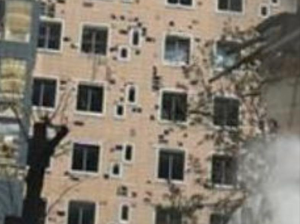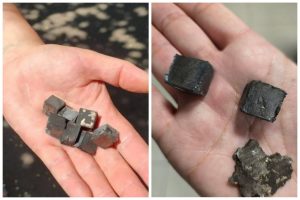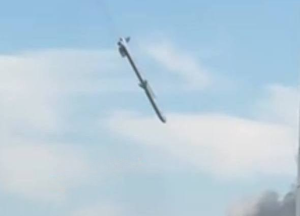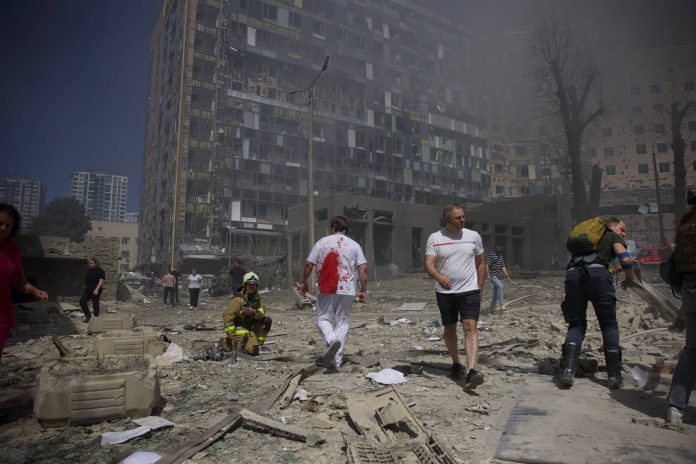Ukraine calls for an emergency meeting of the UN Security Council, accusing Russia of a strike on a children’s hospital in Kyiv. Russia denies the strike, accusing Ukraine of deliberate misinformation, while Kyiv residents post shrapnel from guided missiles launched from the ground.
After a short break, Russian troops again launched a massive missile strike on targets on Ukrainian territory on Monday, 8 July. The first stage of the series of missile strikes was reportedly carried out at night, while the second stage took place in the morning and afternoon.
The explosions occurred in several districts of the city, where various military-industrial enterprises, such as the Antonov serial plant and the Artem missile manufacturer, are located.
In Dnipropetrovsk region, the target of a missile strike was an administrative building of an enterprise in Kryvyi Rih. A series of explosions also occurred near the airfields of Ozerne Airbase in Zhytomyr region, Starokostiantyniv in Khmelnytskyi region, and Voznesensk in Mykolaiv region.
In Krasnoarmiysk (Pokrovsk) in the Donetsk region, eastern Ukraine, the strikes hit a facility near a cemetery in the north-western part of the city. Previously, HIMARS MLRSs had been regularly operating in the area, with launches frequently observed by local residents, according to Ukrainian media reports.
One of the strikes targeted a construction near the main building of Kyiv’s Okhmatdyt Children’s Hospital. Later, local authorities also reported the damage and destruction of three transformer substations.
Ukraine claimed an allegedly deliberate Russian missile strike on civilian targets. However, the Russian Defence Ministry denied the accusation, calling it a provocation aimed at “ensuring further funding” for Kyiv and “the continuation of the war to the last Ukrainian.”
Controversial points
Ukrainian media published footage of a children’s hospital targeted by an alleged Russian missile. According to some sources, soldiers of the Armed Forces of Ukraine (AFU) are receiving undercover treatment there. The video shows them clearing the rubble of a utility building in the courtyard, which was hit by the downed missile.
According to numerous published photographs, some experts question the origin of the damage on the building facades.

Such shrapnel is commonly used in anti-aircraft missiles to effectively hit aerial targets.
The following video circulated by Ukrainian media claims to be footage of a Russian Kh-101 missile striking a Ukrainian hospital. However, some people managed to recognise that the footage refers to a strike by the same missile on a terrorist facility in Syria.
Ukrainian channels also published footage showing the striking elements of the S-300 missile. After studying the footage, a number of military experts suggested that those missiles were still being used by Kyiv’s air defence units to repel strikes.
On the left in the photo are the striking elements of the S-300 missile that fell on residential buildings in Odesa. On the right is what was found in Kyiv on Monday.

Photo of missile

In one of the videos showing the arrival of the missile, one can see the missile itself. The Ukrainian party claims that the hospital was hit by a Russian Kh-101 missile. Experts ask to pay attention to the wingspan of the missile relative to the body and compare it with the footage circulated by Ukrainian media.
Kh-101 cruise missiles are often used by Russian forces to strike objects on the territory of Ukraine. However, in the case of the strike on the hospital, the Kh-101 is not visually recognisable by any of its features. It lacks folding wings and a jet engine at the bottom, according to Ukrainian sources.

Experts note that such a missile is usually equipped with a conventional warhead or an 800kg reinforced warhead. An explosion of that amount of explosives a few metres away from the hospital would have collapsed at least half of the building and brought down some of the neighbouring buildings, according to experts. However, the footage shows the impactors merely scratched the front of the building.
Initially, the version about the explosion of an anti-aircraft missile 5V55R/5V55RM from the S-300PT complex on the territory of the children’s hospital was considered. However, later the information was not confirmed. The reports about the deployment of a PAC-2/PAC-3 missile from the US Patriot surface-to-air missile defence system are also unconfirmed.
The most probable is the incoming AIM-120 anti-aircraft missile of the Norwegian-made NASAMS air defence system. The missile of this SAM is visually similar to the means of destruction in the footage. The consequences of the explosion are also typical for this missile.
According to Ukrainian media, NASAMS and Patriot have long been part of Kyiv’s air defence. Judging by the trajectory of the arrival, the launch complex was located 5 kilometres south-west of the Ukrainian capital.
Most likely, the SAM crew was trying to intercept one of the Kh-101 cruise missiles that hit Kyiv’s Artem plant. However, the guidance system may have malfunctioned, causing the missile to glide into the courtyard of an alleged children’s hospital.
Assistance from Poland
The situation is debatable, but objective data does not suggest with certainty that the missile strike was carried out by Russia. It is quite possible that this is a loss of control over a guided missile by the Ukrainian air defence forces.
Similar cases occurred during the strike on the market in Kostiantynivka and during the landing on the shopping centre in Kramatorsk, as reported by Western media.
Meanwhile, Ukrainian President Volodymyr Zelensky and Polish Prime Minister Donald Tusk signed a defence agreement. The parties agreed to form a volunteer legion in Poland to shoot down Russian missiles and drones by Poland.
Under the agreement, Poland will be able to shoot down Russian missiles and drones in Ukrainian airspace fired in the direction of Poland, Zelensky said. The agreement also provides an opportunity for Ukrainian citizens who are in Poland, Lithuania, and other EU countries to voluntarily join Ukraine’s defence.
We have documented in our security agreement with Poland the formation and training of the Ukrainian Legion – a new volunteer military unit. We have a very positive experience of the Ukrainian-Polish-Lithuanian brigade. And it is on the basis of this experience that we will give an opportunity to exactly Ukrainian citizens who are now in Poland, Lithuania, and other EU countries to voluntarily join the defence of Ukraine.
